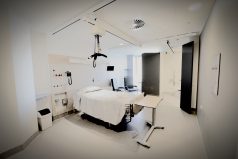The Safety Manager of a 350-hospital bed Medical Center has become concerned since an increase of 20 employee patient handling injuries at the turn of the 4th Quarter of the current Fiscal Year. It is noted that injury increases did not begin until the Safe Patient Handling consultant service that was purchased along with the facility’s $1.5 million comprehensive patient-lift equipment expansion project ended their contract just under 2 years ago. The Safety Manager is unsure why staff has suddenly stopped using available patient-lift equipment. The manager has considered purchasing more equipment as a solution while contemplating the development of a Safe Patient Handling coordinator position. The Medical Center is planning to relocate in 3 years and hospital administration is in support of continuing its “No-Lift” program. The Safety Manager is desperate for a long-term solution as the facility begins planning for the move into their new building location.
Interventions:
- The Safety Manager has contacted several vendors to discuss the purchase of additional equipment.
- The Safety Manager has developed a partnership with the Physical Therapy Department and feels comfortable in selecting one of its staff members to head the Safe Patient Handling program.
- The Safety Manager’s idea for how the Safe Patient Handling Coordinator’s role should function includes working as a non-administrative staff who is responsible for maintaining a high level of visibility on nursing units, training and teaching staff on the various units how to use equipment throughout the workday.
- The Safety Manager plans to align the Safe Patient Handling Coordinator’s role under the Rehab Department.
- The Safety Manager seeks to duplicate the Safe Patient Handling Program established by the original vendor who provided the facility’s initial consulting services.
Considerations:
The Safety Manager is somewhat at a disadvantage being that he has no clinical or patient care experience. The only program model the manager has seen in the form of an injury prevention program consisted of the original consultant service whose purpose was to ensure that program outcomes could only be generated through the continuous purchase of their consulting services. The manager’s thoughts are limited being that there is insufficient knowledge for how the roles of nurses and therapists function in hospital settings. The new consultant’s challenge consists of realigning the safety manager’s thinking in order to create a Safe Patient Handling program capable of integrating into clinical practice. The following suggestions were presented:
- Perform an Injury Prevention System Assessment to validate utilization of the medical center’s current patient-lift equipment. The assessment should serve as a template which not only provides the necessary guidance for how to address existing patient lift challenges to include reports of underutilization, but also used to project equipment needs as plans are made to relocate into a new building location.
- The newly created SPH Coordinator’s position should align under the clinical department who stands to gain or lose the most as a direct result of the successes or failures of the Safe Patient Handling program. The Nursing Department has very specific influence over whether staff chooses to use patient-lift equipment to lift and move patients. The Safety Manager admittedly had not included nursing leadership in any of the decision making related to the current Safe Patient Handling program. This partly explains why equipment usage is down on most nursing units. The reality for most hospital organizations is that Nursing oversees a greater number of units where patient-handling tasks consistently takes place. This means that nursing “buy-in” is essential if the overall goal is to create the greatest reduction in employee injuries.
- Registered Nurses, Physical Therapist, Occupational Therapists, and Industrial Hygienists/Ergonomist are typically selected to lead SPH programs. Whereas it is possible for other clinicians to run successful programs, a Registered Nurse who has bedside experience is more relatable to bedside patient-lift practices making it more likely for them to become the necessary change-influence needed for nursing staff to modify outdated lifting practices.
- A Safe Patient Handling program must be created consistent with the organizations clinical work culture. Understanding the patient care environment allows individuals interested in creating an injury prevention program to implement patient-lift processes that staff is more likely to accept. It is important to understand that most Safe Patient Handling Consulting services are interested in creating programs which requires the facility to consistently depend on their services to achieve optimal program outcomes. It is recommended that organizations organize internal resources which creates the best opportunity to sustain a Safe Patient Handling program long-term.
Outcomes:
The organization accepted these recommendations but opted to continue implementing their program as originally intended. The financial committee has since began to feel as though the facility has not reached its full return on investment potential. New talks of initiating a new project is underway as the facility prepares to move into their new building.





